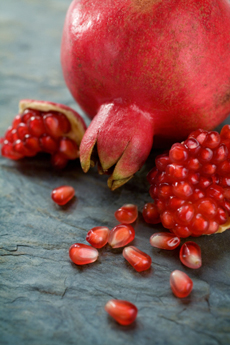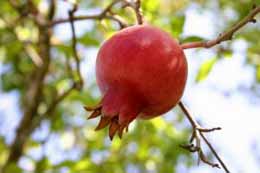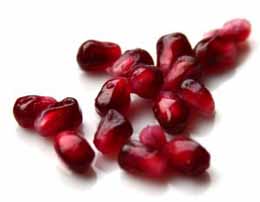The pomegranate has been mentioned in biblical tales, and some debate exists regarding whether it was a pomegranate, not an apple, that enticed Eve in the Garden of Eden. The fruit received mention in the writings of Homer, as well as in Greek mythology: It was a pomegranate that tempted Persephone while in the underworld with Hades. Many cultures consider it to be a symbol of fertility, health and prosperity. The round fruit, which has a spiky, flared crown, can be as small as an orange or as large as a grapefruit, depending on variety. Pomegranates have shiny, leathery skin, which can be anything from deep brick red to yellow. The beautiful whole fruits are often used as decorations. Inside, the fruit consists of around 800 crunchy seeds† surrounded by juice sacs (these are called arils), which are suspended in membranes. Arils (see the photo below) can be vivid ruby red, pale pink or even white, depending on the particular variety of pomegranate. Pomegranates preferred for eating contain large arils filled with a sweet, refreshing and slightly tart juice. The many varieties of the fruit differ in terms of sweetness and juice-to-seed ratio. Some can be extremely astringent or even sour; seedless and soft-seeded varieties exist as well. †You will read in a variety of sources that there are 840 arils. Are there exactly 840 arils in every pomegranate, we asked? According to some sources, this is true for at least three different varieties of pomegranate. Author Alissa Dicker offered to buy a few pomegranates to verify this herself, but we considered it above and beyond the call of duty, and declined her offer. Instead, she called the experts at POM Wonderful, who have counted the arils and found that the number of arils does vary. Not surprisingly, the smaller varieties have fewer. — The Editors The American Pomegranate Spanish sailors are credited with bringing the fruit to Florida, sometime around the 16th century. Today, nearly all of America’s commercial crop come from California’s San Joaquin Valley, where pomegranates are harvested, by hand, from August through December. Most American pomegranates are of the variety called Wonderful, which has large, sweet, juicy, red arils and a dark red rind. Pomegranate concentrate is also imported from the Middle East, from a different variety, which causes the juice to taste somewhat different—just as a Valencia orange and a Seville orange produce juice with somewhat different flavor notes. Pomegranate Arils & Juice Arils, which burst open when bitten, can be eaten as they are (see below for Photo of arils by Alaina Cherup | SXC. Eating pomegranate seeds can be a messy endeavor (the methods discussed below should help make it a little neater), and some people grapple over whether to spit out the seed inside each aril (we always eat them—that crunch packs loads of fiber—but our editor spits them out; it’s a matter of personal preference). This may partly explain why the fruit is often pressed into juice. Pomegranate juice is drunk as it is, or used to make pomegranate syrup, molasses, sorbet, and jelly. Also, it can be fermented into a kind of wine. The juice is cooked with walnuts and poultry to make a traditional Persian stew called fesenjan. True grenadine is the product of pomegranate juice cooked with sugar syrup, although most of what’s found in today’s Shirley Temple is synthetic. Continue To Page 3: How To Eat A Pomegranate
Recent Articles From Our NutriNibbles™ News Feed:Subscribing notifies you whenever
there are
|

The Nibble Blog
The Latest Products, Recipes & Trends In Specialty Foods
The gourmet guide you’ve been waiting for. New food adventures are served up daily. Check it out!

Food Glossary
Our Food Directories Are "Crash Courses" In Tasty Topics
Your ultimate food lover’s dictionary packed full of information and historical references. Take a look!

Food History
Let the journey begin!
Learn about the history Of 1,000+ Favorite Foods & Beverages Let’s explore the history of your favorie goods together.Let the journey begin!



 how to release them from the fruit) or used in other preparations. For both flavor and color, they make lovely additions to fruit salads; a great topping for yogurt, cereal, and mixed salads; a tart and satisfying garnish for meats and fish, dips, and desserts. A medium pomegranate (about 9 ounces) will yield approximately three-quarters cup of arils.
how to release them from the fruit) or used in other preparations. For both flavor and color, they make lovely additions to fruit salads; a great topping for yogurt, cereal, and mixed salads; a tart and satisfying garnish for meats and fish, dips, and desserts. A medium pomegranate (about 9 ounces) will yield approximately three-quarters cup of arils.